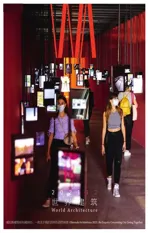成长的烦恼
——从威尼斯建筑双年展的主题展看转型中的建筑学
2021-01-13张利ZHANGLi
张利/ZHANG Li
如果说在当今的时代各个古老的学科正在经历新的成长烦恼,那么建筑学肯定是位列其中的。技术的戏剧性进步导致生活方式的剧变,气候与环境的全球挑战导致关键设计问题域的彻底更新,这些都再次把现存的建筑学体系推向了生存危机之中。
所幸的是,这种学科体系的生存危机在建筑学发展历史上是出现过的。一个多世纪以前,工业革命就带给建筑学同样的冲击,也曾经造就了我们熟悉的建筑学范式的大挪移——从完全的艺术人文体系转向部分实证的技术与艺术融合体系,直至20世纪中后期。在历经了对CIAM现代功能城市的反思、对“解题”(problem-solving)式设计假说的质疑后,建筑学在20世纪末实现了与激进的当代艺术的汇合,其范式回归到了艺术人文体系。不过,正所谓“三十年河东,三十年河西”——事实上还不到30年——现在,建筑学又到了技术与现实驱动下的大转型期。
这一转型以超过人们预期的速度渗透到建筑学的各个角落,直至威尼斯国际建筑双年展这一预示建筑学走势的标识性事件。哈希姆·萨基斯在2019年为第17届威尼斯建筑双年展提出“我们将如何共同生活”的主题。这一主题平易近人,一改威双前卫激进的传统,迅速引起学界的积极反响,从一定程度上反映了国际上对建筑学转型的共同期待。2020年新冠疫情的世界范围蔓延掀起建筑学对自身范式进行反思的浪潮、2021年COP 26前后的全球讨论促使建筑学思考应该以何种方式贡献于气候变化应对及碳中和大计,这些都使学界对建筑学转型的态度由期待变为亟需。人们的眼光自然也会聚焦到2021年夏天面世的威尼斯国际建筑双年展军械库主题展上,试图从中看到建筑学转型的端倪。
然而让人略感遗憾的是,此次威双主题展参展作品仍然或多或少地呈现着一种“意识”与“干预”(或“说”与“做”)之间的反差,也提示我们此次的建筑学转型绝非一种当机立断式的速成,而会是一种漫长的、伴随着无限烦恼的成长。从这些展品中我们看到,不论是问题的定义还是方法的采用,现有建筑学都在试图进行某种程度的自我革新;但同时我们也看到,囿于现有建筑学知识体系的局限,很多情况下,人们不得不沿用过去的工具来试图解决现在乃至未来的问题,数十年来形成的建筑学舒适区域的惯性是依然存在的。其中,最明显的是以视觉吸引为目的的形式与以社会生活为指向的内容之间的距离。比如,黑曜石美妙的晶体阵列对于激发对殖民历史的反思很可能是无助的,因为对这些岩石所直观承载的地质学历史而言,殖民史只不过是昙花一瞬;类似的,婆娑蔓延的有机形态装置对疫情之下的公共空间属性探寻来说恐怕也是力不从心的,因为对诗性自然空间的普遍性渴望在此既不能传递疫情下公共空间的特殊需求,也不能提供任何关于疫情下维系公共生活的哪怕是尝试性的建议。
这就把我们引向了另外的恼人问题:在当前的建筑学转型背景下,纯粹概念化的、叙事化的方案呈现究竟还有没有意义?在揭示我们学科发展动态的展览中,我们是需要更多供人把玩、思考的盆景,还是供人体验、测试的可复制应用场景?如果再把问题问得大一些,当我们的共识是通过设计来改变生活时,这种改变的力量是更多来自于主观的哲学诠释与思辨,还是客观的科学量度、纠错与证明?□
Architecture is definitely among the list of ancient professions having new growing pains. The advancements of technologies have produced upheavals of life styles. The global climate change has caused overhauls of the body of knowledge in the discipline. Needless to say, architecture, for yet another time, is facing existential crisis.
Fortunately, architecture has survived previous existential crises. About a century ago, the challenge to architecture brought by industrial revolution was equally huge. It did end up in a complete paradigm shift, from a pure system of liberal art to a hybrid system of art and technology. It was in the middle of the 20th century though, that a widely accepted rebellion against the CIAM functional city doctrines and a rethinking of the legitimacy of "problem-solving" design methodology put architecture back on the track of pure art. Several decades later, at the moment, we are witnessing another paradigm shift towards technology, social life and sustainability.
The new context of digital age means that when a paradigm shift takes place, it goes faster and further. This time, it is clearly seen in the very heart of the artistic scene of architecture: Venice Biennale. Hashim Sarkis'How will we live togethergenerated a mass appeal which the previous elite Biennales hadn't. All of a sudden, it became a beckon of new architecture paradigm, and a signal of new architectural consensus. What Sarkis and his colleagues hadn't planned was the pandemic in 2020, which pushed the Biennale back for an entire year and ironically strengthened the power of the theme. COP26 in 2021 and Carbon Net Zero added to the relevance of the theme even more. Everyone in the architecture world was looking seriously at the opening of this Biennale in May 2021, anticipating for some urgently needed answers, or at least some hints to answers, to the global questions.
It was proved to be a towering demand to the main exhibition at Arsenale, a demand not completely satisfied by the supply. Works in the main exhibition carry the familiar discrepancy betweenawarenessandintervention, which may signify that the current paradigm shift in architecture, faster than before as it may be, would still be a lengthy and painful one. Growing pains are inevitable. While facets of attempts of new definitions and new solutions are indeed found in all of them, so are obstinacies. Thanks to the comfort zone of the architecture discourse over the past few decades, traditional tools/methods are used to solve new problems. Visual attraction is still dominant, no matter how far away it is from the problem it tries to render. For example, using the matrix of obsidian to interpret the agonies of the colonial time might not elicit much resonance, since the colossal geological history of the beautiful rocks dwarfs the colonial history to a mere moment in time. Similarly, using the pseudo-organic clouds to depict public space under Covid might be confusing, because neither the peculiarities of living under Covid nor the particular hardship of facilitating public life in the real space with the virus going around can be represented by the seemingly common, generic, albeit good-looking geometry.
That ambiguity, or somewhat slight lack of coherence, leads us to more haunting questions: how much longer shall the pure conceptual or theatrical architecture be relevant in this time of rapidly changing life? In the architecture exhibitions that are yet to come, are we still expecting ideological setups that are meant to provoke and to be disputed upon, or applicable scenes that are meant to be tried, experienced, and tested? Or, if we dare to ask a bigger question, when the current consensus is design bringing change to everyone's life, should this change be powered by traditional subjective narratives and interpretations, or by the new objective data, adaptation and test runs? □
